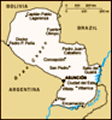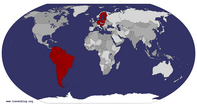Advertisement
The bus to Asuncion, for which I had bought a ticket the previous day, was cancelled 10 minutes before it was due to leave (despite this being with Rysa - the alleged most reliable bus company). Luckily the company gave me a full refund and I only had an hour to wait until the next departure with another company. You can tell that they’re not used to many foreigners visiting - the bus company copied my name off of my passport onto the ticket as “Graeme John British Citizen”. In the interval before the new bus was scheduled to leave, another bus arrived carrying a cargo of packs of toilet paper, which had to be transported to the first floor of the bus terminal. This precipitated a competition between a group of lads to see who could throw the most packs into the window upstairs, though most seem to miss, bursting the packs and sending toilet rolls in all directions. The bus I eventually caught turned out to be much older than the standard inter-city buses that I’m used to, and although it got there safely, it was a lot slower, so I didn’t actually arrive until after dark despite setting
off at 10:30. The bus terminal was quite far out of the centre, but luckily I managed to get on the right bus to the centre and get off near enough to where I wanted to. I ended up at the Hotel Embajador, one of the cheapest hotels in the centre, but it was nice enough, though a bit rough around the edges. But for only 30,000 Guaranís (just over 4 pounds) a night, it was good value, especially as it was 1 block from the main square. I actually stayed in the same hotel for a week, as I found enough things in and around Asunción to keep me entertained for that duration, though I was by no means rushing through things. Annoyingly for 2 nights the hotel had no electricity though - the whole block was cut off for some reason I didn’t quite comprehend.
In hindsight, I have timed my travelling to Asunción very badly. Not only did I miss the Paraguayan national day (May 14th), I arrived in Asunción on 24th May, one day before the Argentinean national day, which this year is in fact their bicentenary. Celebrations in Buenos Aires were quite something, so
I heard, but it’s just unfortunate that I couldn’t wait around in Argentina a few more days.
Asunción is a bit of a diamond in the rough. That's probably going too far - maybe a zircon in the rough would be more fitting. There are some very nice buildings in and around the centre, but a few are decaying and some areas are definitely neglected. Asunción was the centre of Spanish rule in the southern half of South America until Buenos Aires was founded, but unfortunately not that many colonial buildings remain as one of the first post-independence Presidents, Dr Francia, was paranoid about being assassinated, so ordered all tall buildings to be demolished so that he would always be able to see a would-be assassin on any roof. Paraguay was at this point one of the most influential countries in South America with the largest army, but after the disastrous War of the Triple Alliance against Brazil, Argentina and Uruguay in the 1860s, it lost half of its territory as well as close to an astonishing 90% of the male population. The country never really fully recovered from this, and didn’t even choose it's first democratically elected president

 Inside the Casa de la Independencia
Inside the Casa de la Independencia
The room where the terms of independence were agreeduntil 1993, but this makes it a very contrasting country to visit.
On my first whole day in the city, I was able to visit most of the central attractions: the Casa de la Independencia, where Independence was declared, was right next to my hotel, and had an interesting museum. The most famous landmark in the city, the Pantheon, contains the remains of some of the country’s war heroes as well as the Tomb of the Unknown Child Soldier from the war of the Triple Alliance. The National Cathedral is strangely located in the middle of a car park at one end of the Plaza de la Independencia, which doesn’t really do it justice. The former seat of government, the Cabildo, is now a museum which was definitely worth the visit. Behind this is Asunción Bay, an inlet of the Paraguay River, complete with shanty town on the river banks. The new seat of government is the Congreso, recently built and co-funded by the Taiwanese government (as Paraguay is one of the few country to recognise Taiwan’s claim to be the legitimate government of China). The main entrance had a startling resemblance to the Le Corbusier chapel in France

 The National Cathedral
The National Cathedral
Set in a large car parkwhere I volunteered last summer. Past the Congreso is the Presidential Palace, unfortunately not open to the public, and behind this is a lovely riverside park, complete with Presidential Helipad. There was a small gunboat moored when I visited - part of the Paraguayan Navy. Even though it’s a landlocked country (one of only 2 in the Western Hemisphere), the country still has a small Navy. The third main square in the city centre, Plaza Uruguaya, contains the city’s former railway station, which is now a railway museum. There are hardly any railways left in the country now, with the exception of a steam train that occasionally runs out of the city suburbs to a nearby lake. The railway museum was quite interesting, though as all the railways were English-built, all the paraphernalia was identical to what you would find in any UK railway museum. The city’s Fine Arts Museum was a definite joke - one small room above the National Archive - definitely not worth the visit, but at least it was free. A 20 minute walk away from the centre, I arrived at the 4th Market, which was crazily big, extending onto many nearby streets, and selling dirt-cheap
counterfeit clothes, watches as well as normal household and food products. Everything in Asunción does seem to be really cheap though. The 2 dozen bananas I bought there set me back a hefty 25p. It’s a nice surprise that everything is cheaper than my guide book quotes, especially as Argentina was so much more expensive than I had expected.
I’m not quite sure what typical Paraguayan food is, as on the face of it, Asunción is dominated by fast food outlets (mostly Paraguayan chains selling chicken, but also a few international chains such as Burger King and Pizza Hut). But Paraguay is definitely one of the least globalised countries in South America, especially after having come straight from Argentina. One snack that everyone seems to eat is a small cheese-flavoured finger roll, called Chipa, which is nice enough. Every bus I get on, at some point some person boards with a basket of hot, freshly baked Chipa to sell to the people on board. Another national delicacy is Sopa Paraguaya (Paraguayan Soup), whose name is somewhat misleading. It is in fact a savoury cake made of corn and cheese, and the one I tried was absolutely revolting. An acquired
taste possibly.
The traffic and pollution in the city are a major problem. As is the sheer amount of litter everywhere. Asunción in these respects very much reminds me of Lima. As there’s no underground system, buses are the main form of public transport, but most of the ones in service aren’t that new and are very polluting. That said, they are excellent value. Like the buses in Lima, every time you use one, you will see so many different people board in order to try to sell something to the people on board; besides hot Chipa, people also sell chocolate, newspapers, orange juice, batteries, brooms, toilet roll amongst others, as well as the most common of all, socks. No idea why, but the city is plagued with sock salesmen and a clear surplus of socks. All of which look very small and of poor quality, but since the last time I went to the launderette all but 3 of my socks disappeared, I have had to make use of these omnipresent salesmen.
Stray dogs and cats are a much bigger problem here than anywhere else of late. There’s so many of them, and a lot are very
mangy. As there are so many of them, and there is also so much traffic, I have seen the evidence of a few road accidents where the dog has clearly come off worse. On a bus just outside the city the lorry ahead of us nearly hit a loose cow, as a lot of livestock seems to roam free (or a lot managed to escape that particular day). There’s so much rubbish on the streets (less so in the historic centre, but definitely in the poorer suburbs), which is where the stray animals feed. On the plus side, there seems to be less poverty here - there are very few beggars compared with Lima for example. But some people do actually make a living out of going through all the rubbish on the street, collecting what’s recyclable, and selling that on. I’ve seen quite a few people emptying black sacks on the street with this purpose (which of courses makes even more mess!).
I haven’t left Asunción yet - my next blog will be about the day trips to the so-called “Golden Circuit” outside the city.
Advertisement
Tot: 0.105s; Tpl: 0.015s; cc: 9; qc: 46; dbt: 0.0654s; 1; m:domysql w:travelblog (10.17.0.13); sld: 1;
; mem: 1.1mb

























